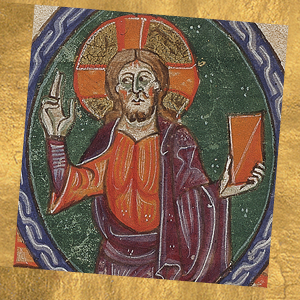St. Rita of Cascia, Agostinian

Margherita Lotti - “Rita” for short - was born in the small township of Roccaporena in Umbria, probably in 1371. Her parents, poor farmers and peasants, made sure she had good schooling and religious education in the nearby Cascia, in the care of the Augustinian friars. From the friars, Rita learned devotion to St. Augustine, St. John the Baptist, and Nicholas of Tolentino, whom Rita chose as his patron saints.
Wife and mother
Around 1385, she married Paolo di Ferdinando di Mancino. Society was rife with controversies and political rivalries, in which Rita’s husband was involved. The young Rita, however, through prayer, patience, and the ability to pacify that she learned from his parents, helped her spouse slowly but surely to live a more authentically Christian way of life. With love, understanding and patience, that of Rita and Paolo became a fruitful union, cheered by the arrival of two male children: Giangiacomo and Paolo Maria. Their domestic serenity would not last, however, owing to the implacable factional strife of the era, in which Rita’s husband was involved owing to his kinship bonds, and was murdered. To avoid having the children seek revenge, Rita hid their father’s bloody shirt. In her heart Rita forgives her husband’s murderers, but the Mancino family refused to let the incident pass unanswered, and pressed for revenge. Rancor and hostility arose. Rita did not cease to pray that more bloodshed be spared, making of prayer her weapon and consolation.Nevertheless, the tribulations did not cease. A disease caused the death of Giangiacomo and Paul Maria: her only comfort was to think of their souls, no longer in danger after escaping the climate of retaliation aroused by the murder of her spouse, their father.
Augustinian nun
Left alone in the world, Rita began a life of more intense prayer for her dear deceased family members, but also for the di Mancino family, that they might forgive and find peace. At the age of 36, she asks to be welcomed by the Augustinian nuns of the Monastery of Santa Maria Maddalena of Cascia, but her request is rejected: the religious, perhaps, feared the entrance of Rita - a widow of a murdered man - whose presence might have jeopardized the security of their community. Rita’s prayers and the intercessions of her patron saints instead lead to the peace between the families involved in the killing of Paolo di Mancino, and after so many obstacles, she was allowed to enter the monastery. It is reported that the Abbess, to try Rita's humility during her novitiate, asked her to water an arid wood, and that her obedience was rewarded by God with a lush growth that flourishes to this day. Through the years, Rita distinguished herself as a humble, zealous religious woman in prayer and in all tasks with which she was entrusted, and as one capable of frequent fasting and penance. Her virtues were also known outside the monastery walls, owing particularly to the charitable works to which Rita was devoted with her sisters. She especially visited the elderly, cared for the sick, and assisted the poor.
The saint of roses
More and more immersed in the contemplation of Christ, Rita eventually asked to be able to participate in his Passion, and in 1432, in prayer, she discovered on her forehead a wound as from the thorny crown worn by the Crucified One, which would remain until her death 15 years later. In the winter before her death, ill and confined to her bed, Rita asked a cousin, visiting from Roccaporena, to bring her two figs and a rose from the garden of her father’s house. It was January. Rita’s visitor humored her, thinking of her delirious.She was astonished to find the rose and the figs, and brought them to Cascia. For Rita, they were a sign of the goodness of God, who welcomed her two sons and her husband into heaven. Rita died in the night between 21 and 22 May of 1447. Because of the great cult that grew up around her immediately afterwards, her body was never buried. Today, her earthly remains are housed in a glass casket. Rita was able to flourish despite the thorns that life reserved for her. She emanated the good perfume of Christ, and melted the frosty winter of so many hearts. For this reason, and in remembrance of the prodigy of Roccaporena, Rita’s symbol par excellence is the rose.
More upcoming events:







 Your contribution for a great mission
Your contribution for a great mission

